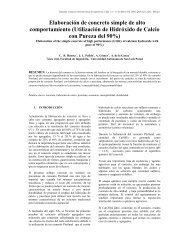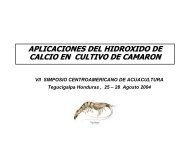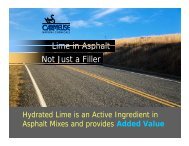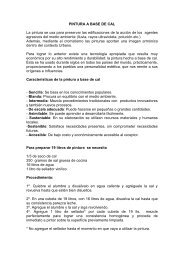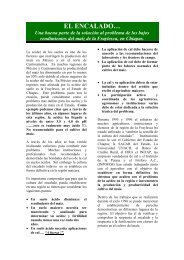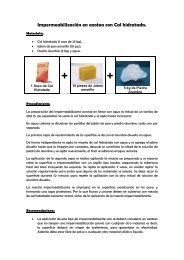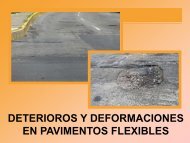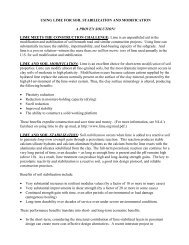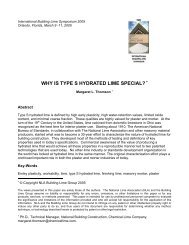Land Contamination: Technical Guidance on Special Sites: Acid Tar ...
Land Contamination: Technical Guidance on Special Sites: Acid Tar ...
Land Contamination: Technical Guidance on Special Sites: Acid Tar ...
Create successful ePaper yourself
Turn your PDF publications into a flip-book with our unique Google optimized e-Paper software.
6.3 Natural Attenuati<strong>on</strong>Natural attenuati<strong>on</strong> refers to the reducti<strong>on</strong> of a c<strong>on</strong>taminant c<strong>on</strong>centrati<strong>on</strong> via naturallyoccurring physical, chemical or biological processes. For petroleum products, depending <strong>on</strong>specific site c<strong>on</strong>diti<strong>on</strong>s, this can be an important factor in reducing c<strong>on</strong>taminantc<strong>on</strong>centrati<strong>on</strong>s, the most important processes being (i) biodegradati<strong>on</strong> by micro-organismsnaturally present in the soil and groundwater; (ii) weathering of surface spillages; and, (iii)volatilisati<strong>on</strong>. Additi<strong>on</strong>al processes include retardati<strong>on</strong>, sorpti<strong>on</strong>, hydrodynamic dispersi<strong>on</strong>and diluti<strong>on</strong>.The main factors that dictate the rate of biodegradati<strong>on</strong> are the oxygen supply (degradati<strong>on</strong> isgenerally more rapid under aerobic c<strong>on</strong>diti<strong>on</strong>s) and the molecular structure of the petroleumproducts. As described in TPHCWG (1998), the rate of biodegradati<strong>on</strong> according tomolecular structure is typically affected as follows:• n-alkanes especially in the C10 – C25 range (e.g. diesel and gasoline) degrade moreeasily;• isoalkanes degrade more slowly;• alkenes degrade more slowly than alkanes;• BTEX degradati<strong>on</strong> occurs if they are in c<strong>on</strong>centrati<strong>on</strong>s not toxic to the microorganismspresent;• PAHs degrade more slowly than m<strong>on</strong>oaromatics; and• degradati<strong>on</strong> of higher molecular weight cycloalkines may be slower.However, c<strong>on</strong>siderati<strong>on</strong> should be given to those chemicals which degrade to more toxicdaughter products.Natural attenuati<strong>on</strong> will not be applicable as a remediati<strong>on</strong> opti<strong>on</strong> <strong>on</strong> all sites, and will <strong>on</strong>ly beacceptable if it can be dem<strong>on</strong>strated that the aforementi<strong>on</strong>ed processes are reducing thepollutant load such that there is no current or future unacceptable risk to receptors or areexpected to do so over an acceptable timescale. A thorough site investigati<strong>on</strong> andcharacterisati<strong>on</strong> is required to understand the hydrogeology and geology of the site, and todetermine whether these processes are active. In additi<strong>on</strong>, natural attenuati<strong>on</strong> will require <strong>on</strong>goingm<strong>on</strong>itoring (not <strong>on</strong>ly of the pollutant, but also for example, oxygen, carb<strong>on</strong> dioxide andmethane c<strong>on</strong>centrati<strong>on</strong>s if biodegradati<strong>on</strong> is occurring) until it can be dem<strong>on</strong>strated that thereis no unacceptable risk to receptors.The main benefits of natural attenuati<strong>on</strong> are (i) treatment plants (and their associated costs)are not required; (ii) avoidance of utilisati<strong>on</strong> of landfill capacity; and (iii) relatively littlesurface disturbance. The main disadvantages are (i) a l<strong>on</strong>g time periods and (ii) the need forc<strong>on</strong>tinuous m<strong>on</strong>itoring and a robust scientific argument. Further informati<strong>on</strong> can be obtainedfrom the Model Procedures, Envir<strong>on</strong>ment Agency R&D publicati<strong>on</strong> 95 (2000) and TPHCWG(1998).R&D <str<strong>on</strong>g>Technical</str<strong>on</strong>g> Report P5-042/TR/04 39



